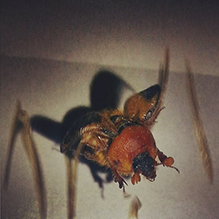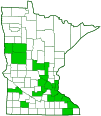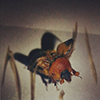Bruner’s earth-boring scarab beetle
(Bolbocerosoma bruneri)
Conservation • Description • Habitat • Ecology • Distribution • Taxonomy
Conservation Status |
|
|||||||
| IUCN Red List | not listed |
|||||||
| NatureServe | NNR - Unranked |
|||||||
| Minnesota | not listed |
|||||||
Description |
||
Bruner’s earth-boring scarab beetle is a colorful, small to medium-sized, beetle. It occurs in the central United States from Michigan to Tennessee, west to North Dakota and Oklahoma, and in southern Ontario Canada. It is the most common member of the genus Bolbocerosoma in the Midwest. Adults are found from April to November in burrows in pastures and on old roads where there is sandy soil. Adults are brownish-orange and black, ⅜″ to 9⁄16″ (8.5 to 14.5 mm) in length, and ¼″ to ⅜″ (6.5 to 9.5 mm) wide. The body is oval when viewed from above, hemispherical when viewed from the side. The head is large and is strongly oriented downward and forward. It is not concealed beneath the pronotum. The neck is extremely short. The jaws (mandibles) are projected forward and conspicuous. On each cheek (gena) there is a brush of long brownish-orange hairs. The plate on the face (clypeus) is usually black above, brownish-orange below. Sometimes it is entirely black. A horny process (canthus) extends laterally from the clypeus and completely divides the eyes. The clypeus is separated from the top of the head (vertex) by a prominent broad ridge. On the male there is a short, erect, undivided horn in the middle of the ridge. The antennae are brownish-orange and have 11 segments (antennomeres). The last three segments are expanded sideways on one side into long flattened lobes. The lobes are convex on both sides. They can be closed into a tight club or fanned out to detect odors. The length of the club is equal to the length of all other antennomeres taken together. The exoskeletal plate (pronotum) covering the first segment of the thorax is broad, convex, and brownish-orange with black markings. It has a thin ridge (carina) near the front behind the head. The rear margin above each wing base is black and there is a black spot on each side near the lateral margin. On the female the carina is sometimes black or has at least a trace of black. The hardened outer forewings (elytra) are brownish-orange and black, and the margins are narrowly flared. They have seven deep grooves, and each groove is strongly pitted (punctate). The inner margin is black. The outer margin is usually black in the shoulder (humeral) area and black in the rear, with brownish-orange between. Sometimes the outer margin is entirely black. A black spot covers most of the rear third to half of each elytron. It merges with the inner margin but is usually separated from the outer margin except at the tip. The plate between the elytra bases (scutellum) is visible, black, small, triangular, and slightly curved on the sides. On the underside of the abdomen there are long but not dense brownish-orange hairs. The first segments of the middle legs are narrowly separated by a slender projection of the mesosternal plate. The legs are stout, hairy, adapted for digging, and mostly brownish-orange. The outer margin of the fourth segment (tibia) of the front leg is edged with dark brown and has usually eight teeth, sometimes seven or nine. The last part of each leg (tarsus), corresponding to the foot, has five segments. The last tarsal segment has two equally sized, undivided claws at the tip. |
||
Size |
||
Total length: ⅜″ to 9⁄16″ (8.5 to 14.5 mm) |
||
Similar Species |
||
Habitat |
||
Pastures, old roads |
||
Ecology |
||
Season |
||
April to November |
||
Behavior |
||
|
||
Life Cycle |
||
|
||
Larva Food |
||
Decomposing plant and animal matter (humus) |
||
Adult Food |
||
|
||
Distribution |
||||
|
Sources Biology and taxonomy of North American beetles of the subfamily Geotrupinae, with revisions of the genera.... H.F. Howden. 1955. Proceedings of the United States National Museum, 104(3342): 151-319, plates 1-18. |
|||
| 9/9/2022 | ||||
Occurrence |
||||
|
||||
Taxonomy |
|||
Order |
Coleoptera (Beetles) | ||
Suborder |
Polyphaga (Water, Rove, Scarab, Long-horned, Leaf, and Snout Beetles) | ||
Infraorder |
Scarabaeiformia | ||
Superfamily |
Scarabaeoidea (Scarabs, Stag Beetles, and Allies) | ||
Family |
Geotrupidae (earth-boring scarab beetles) | ||
Subfamily |
Bolboceratinae | ||
Tribe |
Bolboceratini (bolbos) | ||
Genus |
Bolbocerosoma | ||
The genus Bolbocerosoma was traditionally placed in the subfamily Bolboceratinae on the family Geotrupidae. Several recent cladistic analyses showed that Bolboceratinae are not closely related to Geotrupidae. In a revision of the Geotrupidae published in 1995, the subfamily Bolboceratinae was raised to family level and given the name Bolboceratidae. Few sources have accepted the move. |
|||
Synonyms |
|||
Bolbocerasoma bruneri (misspelling) |
|||
Common Names |
|||
Bruner’s earth-boring scarab beetle |
|||
Glossary
Clypeus
On insects, a hardened plate on the face above the upper lip (labrum).
Elytra
The hardened or leathery forewings of beetles used to protect the fragile hindwings, which are used for flying. Singular: elytron.
Gena
In insects: The area between the compound eye and the mandible; the cheek. In birds: The area between the the angle of the jaw and the bill; the feathered side (outside) of the under mandible. Plural: genae.
Pronotum
The exoskeletal plate on the upper side of the first segment of the thorax of an insect.
Punctate
Dotted with pits (punctures), translucent sunken glands, or colored spots of pigment.
Scutellum
The exoskeletal plate covering the rearward (posterior) part of the middle segment of the thorax in some insects. In Coleoptera, Hemiptera, and Homoptera, the dorsal, often triangular plate behind the pronotum and between the bases of the front wings. In Diptera, the exoskeletal plate between the abdomen and the thorax.
Tarsus
On insects, the last two to five subdivisions of the leg, attached to the tibia; the foot. On spiders, the last segment of the leg. Plural: tarsi.
Tibia
The fourth segment of an insect leg, after the femur and before the tarsus (foot). The fifth segment of a spider leg or palp. Plural: tibiae.
vertex
The upper surface of an insect’s head.
Visitor Photos |
|||||
Share your photo of this insect. |
|||||
| This button not working for you? Simply email us at info@MinnesotaSeasons.com. Attach one or more photos and, if you like, a caption. |
|||||
Angela Garrett |
|||||
in flight (photo snapped at take-off!) |
 |
||||
MinnesotaSeasons.com Photos |
|||||
|
|||||

Slideshows |
||

Visitor Videos |
|||
Share your video of this insect. |
|||
| This button not working for you? Simply email us at info@MinnesotaSeasons.com. Attach a video, a YouTube link, or a cloud storage link. |
|||
Other Videos |
|||


Created: 9/9/2022
Last Updated:

